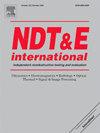A novel damage localization method of Circular Phased Array using Minimum Variance Distortionless Response Beamforming with Autocorrelation Matrix Diagonal Loading
IF 4.5
2区 材料科学
Q1 MATERIALS SCIENCE, CHARACTERIZATION & TESTING
引用次数: 0
Abstract
Damage localization methods based on Acoustic Emission (AE) can be classified into time-based and waveform-based. However, the former requires a large number of sensors while the latter is limited to 2D plane localization. In order to address the challenge of achieving more accurate 3D localization using a reduced number of sensors, this paper proposes a Circular Phased Array using Minimum Variance Distortionless Response (MVDR) Beamforming with Autocorrelation Matrix Diagonal Loading (AMDL) method. Firstly, a sparse circular array is utilized to form multiple beamforming for coherent shear wave signals, decomposing the original 3D localization problem into Direction Of Arrival (DOA) estimation. Secondly, azimuth angle, elevation angle and autocorrelation matrix diagonal loading methods are introduced, working in conjunction with the MVDR beamforming algorithm. Finally, spatial integration is performed through matrix decomposition to solve geometric overdetermined equations. The effectiveness of the proposed method is validated through numerical simulations and experimental verifications under various damage conditions. Results indicate that estimation errors for azimuth and elevation angles are both less than 2 %, while 3D damage source localization errors remain within a range of less than 3 %. This proposed method extends beamforming technology from 2D plane localization to 3D localization, significantly reducing the complexity of sensor arrangement and lowering the cost of structural health monitoring systems by utilizing a small number of sensors.
利用自相关矩阵对角线加载的最小方差无失真响应波束成形的新型圆形相控阵损伤定位方法
基于声发射(AE)的损伤定位方法可分为基于时间的方法和基于波形的方法。然而,前者需要大量传感器,而后者仅限于二维平面定位。为了解决用更少的传感器数量实现更精确的三维定位这一难题,本文提出了一种使用自相关矩阵对角加载(AMDL)方法的最小方差无失真响应(MVDR)波束成形的圆形相控阵。首先,利用稀疏圆形阵列形成相干剪切波信号的多重波束成形,将原来的三维定位问题分解为到达方向(DOA)估计。其次,引入方位角、仰角和自相关矩阵对角加载方法,与 MVDR 波束成形算法结合使用。最后,通过矩阵分解进行空间整合,以求解几何超定方程。在各种损坏条件下,通过数值模拟和实验验证了所提方法的有效性。结果表明,方位角和仰角的估计误差均小于 2%,而三维损伤源定位误差保持在小于 3% 的范围内。该方法将波束成形技术从二维平面定位扩展到三维定位,大大降低了传感器布置的复杂性,并通过利用少量传感器降低了结构健康监测系统的成本。
本文章由计算机程序翻译,如有差异,请以英文原文为准。
求助全文
约1分钟内获得全文
求助全文
来源期刊

Ndt & E International
工程技术-材料科学:表征与测试
CiteScore
7.20
自引率
9.50%
发文量
121
审稿时长
55 days
期刊介绍:
NDT&E international publishes peer-reviewed results of original research and development in all categories of the fields of nondestructive testing and evaluation including ultrasonics, electromagnetics, radiography, optical and thermal methods. In addition to traditional NDE topics, the emerging technology area of inspection of civil structures and materials is also emphasized. The journal publishes original papers on research and development of new inspection techniques and methods, as well as on novel and innovative applications of established methods. Papers on NDE sensors and their applications both for inspection and process control, as well as papers describing novel NDE systems for structural health monitoring and their performance in industrial settings are also considered. Other regular features include international news, new equipment and a calendar of forthcoming worldwide meetings. This journal is listed in Current Contents.
 求助内容:
求助内容: 应助结果提醒方式:
应助结果提醒方式:


